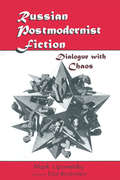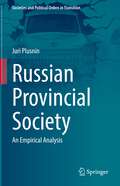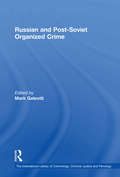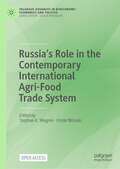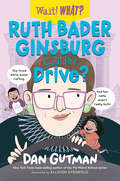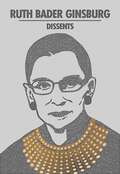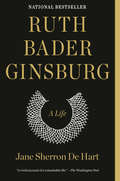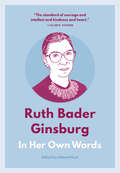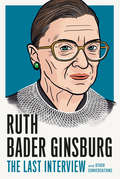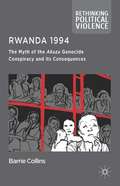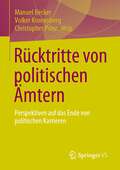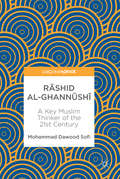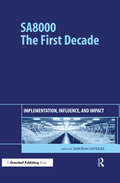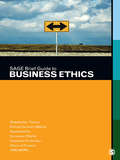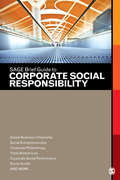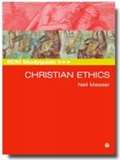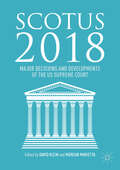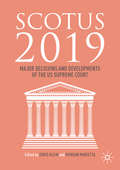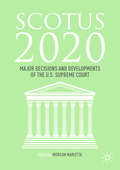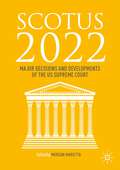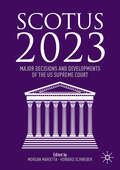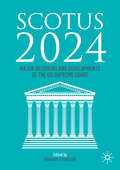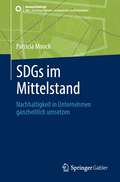- Table View
- List View
Russian Postmodernist Fiction: Dialogue with Chaos
by Eliot Borenstein Mark LipovetskyThis text offers a critical study of postmodernism in Russian literature. It takes some of the central issues of the critical debate to develop a conception of postmodern poetics as a dialogue with chaos and places Russian literature in the context of an enriched postmodernism.
Russian Provincial Society: An Empirical Analysis (Societies and Political Orders in Transition)
by Juri PlusninThis book presents a unique analysis of modern Russian provincial society. Based on detailed empirical evidence, it develops a theoretical model of Russian provincial society in the late 20th century and the early 21st century. The book explains how under the conditions of catastrophic changes, Russian provincial societies have undergone a structural transformation. It further sheds light on the transformation of the economic behavior of the population and households with regard to economic practices, crafts, and revived archaic forms of labor behavior. Summarizing the extensive empirical evidence, the book puts forward the concept of complementarity of two social structures at the local level: a ground "soft communal" structure and a "tightening with an iron hoop" estate state structure. Next, it discusses the stability and resistance of the local social structure to external political disturbances. Based on the presented analysis, the book introduces several independent criteria on the basis of which it establishes the typology of all empirically observed forms of societies. Subsequently, the book identifies six main types of Russian provincial societies. It explains how depending on the type, the different societies either adapt to political and economic changes in different ways, stay unchanged or transform their structure. The book will appeal to students, scholars, and researchers of economics, political science, sociology, and anthropology, interested in a better understanding of transformation studies, population and household economics, provincial societies, as well as Russian societal structures.
Russian Roulette: The Inside Story of Putin's War on America and the Election of Donald Trump
by David Corn Michael Isikoff<P>The incredible, harrowing account of how American democracy was hacked by Moscow as part of a covert operation to influence the U.S. election and help Donald Trump gain the presidency. <P>RUSSIAN ROULETTE is a story of political skullduggery unprecedented in American history. It weaves together tales of international intrigue, cyber espionage, and superpower rivalry. After U.S.-Russia relations soured, as Vladimir Putin moved to reassert Russian strength on the global stage, Moscow trained its best hackers and trolls on U.S. political targets and exploited WikiLeaks to disseminate information that could affect the 2016 election. <P>The Russians were wildly successful and the great break-in of 2016 was no "third-rate burglary." It was far more sophisticated and sinister -- a brazen act of political espionage designed to interfere with American democracy. At the end of the day, Trump, the candidate who pursued business deals in Russia, won. And millions of Americans were left wondering, what the hell happened? This story of high-tech spying and multiple political feuds is told against the backdrop of Trump's strange relationship with Putin and the curious ties between members of his inner circle -- including Paul Manafort and Michael Flynn -- and Russia. <P>RUSSIAN ROULETTE chronicles and explores this bizarre scandal, explains the stakes, and answers one of the biggest questions in American politics: How and why did a foreign government infiltrate the country's political process and gain influence in Washington? <P><b>A New York Times Bestseller</b>
Russian and Post-Soviet Organized Crime (The\international Library Of Criminology, Criminal Justice And Penology Ser.)
by Mark GaleottiA timely look at a widespread yet largely uninvestigated area of Russian life. Chapters include: consideration of the history and basis in culture for the organization of crime in Russia; the actions of emigres to the USA; and the development of modern sophistications of exchange and networking that currently blight privatization. Diverse perspectives, including comparative, structural and ethnic frameworks, give unprecedented national and international insights into a pervasive element of modern Russia.
Russia’s Role in the Contemporary International Agri-Food Trade System (Palgrave Advances in Bioeconomy: Economics and Policies)
by Stephen K. Wegren Frode NilssenThis Open Access book analyses the emergence of Russia as a global food power and what it means for global food trade. Russia's strategy for food production and trade has changed significantly since the end of the Soviet period, and this is the first book to take account of Russia's rise as a food power and the global implications of that rise. It includes food trade policy and practice, and developments in regional food trade. This book will be of interest to academics and practitioners in agricultural economics, international trade, and international food trade.
Ruth Bader Ginsburg Couldn't Drive? (Wait! What? #0)
by Dan GutmanFrom the best-selling author of My Weird School: a new entry in the cheerful and engaging biography series centered on high-interest historic figures. Did you know that Ruth Bader Ginsburg failed her driving test five times? Or that her real name was Joan? Bet you didn’t know that she liked paddle boarding, white water rafting, and riding elephants! She even had a praying mantis named after her. Siblings Paige and Turner have collected some of the most unusual and surprising facts about one of the most famous Supreme Court Justices in history, from her childhood to her rise as the superstar Notorious R.B.G. Narrated by the two spirited siblings and animated by Allison Steinfeld’s upbeat illustrations, Ruth Bader Ginsburg Couldn’t Drive? is an authoritative, accessible, and one-of-a-kind biography infused with Dan Gutman’s signature zany sense of humor.
Ruth Bader Ginsburg Dissents (Word Cloud Classics)
by Ruth Bader GinsburgA collection of key dissenting and majority opinions from U.S. Supreme Court justice Ruth Bader Ginsburg.During her 27 years as an associate justice on the U.S. Supreme Court, Ruth Bader Ginsburg became well known for her strongly worded dissenting opinions against the decisions of the conservative majority. Ginsburg was a fierce supporter of women&’s rights whose personal experiences helped shape her into a feminist icon who employed logical, well-presented arguments to show that gender discrimination was harmful to all members of society. Ruth Bader Ginsburg Dissents features 15 legal opinions and briefs, including majority and dissenting opinions that Ginsburg drafted during her time on the U.S. Supreme Court and briefs from her career before she was appointed to the court in 1993.
Ruth Bader Ginsburg: A Life
by Jane Sherron de HartThe first full life—private, public, legal, philosophical—of the 107th Supreme Court Justice, one of the most profound and profoundly transformative legal minds of our time; a book fifteen years in work, written with the cooperation of Ruth Bader Ginsburg herself and based on many interviews with the justice, her husband, her children, her friends, and her associates. <P><P>In this large, comprehensive, revelatory biography, Jane De Hart explores the central experiences that crucially shaped Ginsburg’s passion for justice, her advocacy for gender equality, her meticulous jurisprudence: her desire to make We the People more united and our union more perfect. At the heart of her story and abiding beliefs—her Jewish background. Tikkun olam, the Hebrew injunction to “repair the world,” with its profound meaning for a young girl who grew up during the Holocaust and World War II. We see the influence of her mother, Celia Amster Bader, whose intellect inspired her daughter’s feminism, insisting that Ruth become independent, as she witnessed her mother coping with terminal cervical cancer (Celia died the day before Ruth, at seventeen, graduated from high school). <P><P> From Ruth’s days as a baton twirler at Brooklyn’s James Madison High School, to Cornell University, Harvard and Columbia Law Schools (first in her class), to being a law professor at Rutgers University (one of the few women in the field and fighting pay discrimination), hiding her second pregnancy so as not to risk losing her job; founding the Women's Rights Law Reporter, writing the brief for the first case that persuaded the Supreme Court to strike down a sex-discriminatory state law, then at Columbia (the law school’s first tenured female professor); becoming the director of the women’s rights project of the ACLU, persuading the Supreme Court in a series of decisions to ban laws that denied women full citizenship status with men. <P><P> Her years on the U.S. Court of Appeals for the District of Columbia Circuit, deciding cases the way she played golf, as she, left-handed, played with right-handed clubs—aiming left, swinging right, hitting down the middle. Her years on the Supreme Court . . . A pioneering life and legal career whose profound mark on American jurisprudence, on American society, on our American character and spirit, will reverberate deep into the twenty-first century and beyond.
Ruth Bader Ginsburg: In Her Own Words (In Their Own Words)
by Helena Hunt&“Like so many cultural icons, Ginsberg has doled out some seriously memorable quotes, thoughts, and observations . . . a quick dip of inspiration.&” —Bustle As one of only nine women in a class of 500 at Harvard Law School when she enrolled in 1956 and one of only four female Supreme Court justices in the history of the United States, Ruth Bader Ginsburg was frequently viewed as a feminist trailblazer and an icon for civil rights. Ginsburg had always been known as a prolific writer and speaker. Now, Ruth Bader Ginsburg: In Her Own Words offers a unique look into the mind of one of the world&’s most influential women by collecting 300 of Ginsburg&’s most insightful quotes. Meticulously curated from interviews, speeches, court opinions, dissents, and other sources, Ruth Bader Ginsburg: In Her Own Words creates a comprehensive picture of Ruth Bader Ginsburg, her wisdom, and her legacy. &“The standard of courage and intellect and kindness and heart.&” —Gloria Steinem
Ruth Bader Ginsburg: and Other Conversations (The Last Interview Series)
by Ruth Bader GinsburgThe newest entry in the increasingly popular series collects fascinating and in-depth interviews with Bill Moyers, Nina Totenberg, and more, and conversations (with Antonin Scalia and high school students) from throughout the long, ground-breaking career of one of the greatest, most influential, and most exciting legal minds in American history.From her start in Depression-era New York, to her final days at the pinnacle of the American legal system, Ruth Bader Ginsburg defied convention, blazing a trail that helped bring greater equality to women, and to all Americans. In this collection of in-depth interviews -- including her last, as well as one of her first -- Ginsburg details her rise from a Brooklyn public school to becoming the second woman on the United States Supreme Court, and her non-stop fight for gender equality along the way. Besides telling the story behind many of her famous court battles, she also talks openly about motherhood and her partnership with her beloved husband, her Jewishness, her surprising friendship with her legal polar opposite Justice Antonin Scalia, her passion for opera, and, in one of the collection's most charming interviews, offers advice to high school students wondering about the law. It is, in the end, both an engrossing look into a fascinating life, and an inspiring tribute to an American icon.
Rwanda 1994
by Barrie CollinsThrough a rigorous critique of the dominant narrative of the Rwandan genocide, Collins provides an alternative argument to the debate situating the killings within a historically-specific context and drawing out a dynamic interplay between national and international actors.
Rücktritte von politischen Ämtern: Perspektiven auf das Ende von politischen Karrieren
by Volker Kronenberg Manuel Becker Christopher PrinzPolitikwissenschaftliche und zeitgeschichtliche Untersuchungen zu den Karrieren deutscher Spitzenpolitiker*innen beschäftigten sich bislang vor allem mit deren Aufstieg und weniger mit dem Ende von politischen Laufbahnen. Aus welchen Gründen treten Politiker*innen aus dem Amt zurück? Was sind die Hintergründe, Motive und Konsequenzen einer solchen Entscheidung? Müssen Rücktritte zwingend Resultat eines Scheiterns sein oder kann es auch „erfolgreiche“ Rücktritte geben? In diesem Band werden theoretische Grundlagen der Rücktrittsforschung aus rechtlicher und politikwissenschaftlicher Perspektive erarbeitet, Rücktrittskulturen in unterschiedlichen Ländern vergleichend untersucht sowie verschiedene Fallbeispiele in ihren spezifischen Einzelfallbedingungen unter die Lupe genommen.
Rāshid al-Ghannūshi̇̄: A Key Muslim Thinker of the 21st Century
by Mohammad Dawood SofiThis book discusses various dynamic facets of the life of Rāshid al-Ghannūshi̇̄, a distinguished Islamic thinker and activist not only in Tunisia and North Africa, but in the entire Muslim world. It especially focuses on those aspects related to his intellectual understanding and response to a number of critical contemporary issues. In the 21st Century, Rāshid al-Ghannūshi̇̄ is considered as the most moderate among the Muslim thinkers and intellectuals, particularly when it comes to the question of Islam-democracy compatibility and power sharing theory. This book also offers an account of a previously little known, yet much talked about Muslim voice in the post-Arab Spring era. It further shows how the intellectual Muslim thinkers’ own perspectives and expectations from Islamic movement(s) and their interaction with the ‘western oriented local leadership’, as well as their (secular) policies color their understanding of Islam and various other major issues.
SA8000: Implementation, Influence, and Impact
by Deborah LeipzigerThis is the first book in the field of corporate social responsibility to examine the progress of a standard over a ten-year period. Published in late 1997 and revised in 2001, the Social Accountability 8000 (SA8000) standard and verification system is a comprehensive tool aiming to assure humane workplaces throughout the supply chain. The SA8000 system includes: factory-level management system requirements for ongoing compliance and continual improvement; independent, expert verification of compliance by certification bodies; the involvement of all key stakeholders in the SA8000 system; and harnessing consumer and investor concern by helping to identify and support companies that are committed to assuring human rights in the workplace. As of 31 December 2007, nearly 700,000 workers were employed in 1,500 facilities certified to SA8000, in 65 countries and 67 industrial sectors.Ten years on, what has the impact of SA8000 been and how do its architects and users see it developing into the future? In this book, businesses, NGOs, academics and trade union leaders provide much-needed perspective on the lessons learned from SA8000 and set an agenda for the next decade. The book also provides context on the leading initiatives within the field of CSR (such as ISO 26000 and the Business for Social Compliance Initiative) and how they relate to SA8000. The book features case studies on the experiences of a wide range of companies, including Gucci, The GAP, Chiquita, TNT, Tata and Otto Versand, and on many of the most innovative programmes in the field of CSR, such as the Made-By label. Analysts from emerging economies provide valuable insights into how SA8000 has become a key tool in Brazil and India. The book addresses many of the key themes for corporate responsibility such as traceability, supply chain management and transparency.SA8000: The First Decade provides insights for company managers, NGOs, policy-makers and trade union leaders on how to implement a social standard and will be required reading for any manager seeking to implement SA8000 or any other code of conduct or standard for their suppliers.Deborah Leipziger is well known for her book The Corporate Responsibility Code Book, published in 2003 and considered to be one of the key reference books in the field of CSR. SA8000: The First Decade is an extension of Ms Leipziger's work over a 17-year career in the field of CSR, in which she has played a role in the development of many social standards, including SA8000 and the Ethical Trading Initiative, and advised many others.
SAGE Brief Guide to Business Ethics
by Sage PublicationsThis guide to business ethics provides key terms and concepts related to business ethics in a short, easy-to-use format. It provides objective coverage of theories, corporate social responsibility, human resources issues, consumer protection, and ethical issues in marketing and advertising. It is an ideal supplement for business ethics courses or as a reference for students and practitioners who would like to learn more about the basics of business ethics.
SAGE Brief Guide to Corporate Social Responsibility
by Sage PublicationsThis guide to corporate social responsibility (CSR) provides discussion of key concepts in a short, easy-to-use format. It is divided into sections on key terms, the global stage, corporate governance, corporate social responsiveness, public relations and philanthropy, and implications for corporate financial performance. It is an ideal supplement for business courses or as a reference for students and practitioners who would like to learn more about the basics of CSR.
SCM Studyguide To Christian Ethics
by Neil MesserThe book covers the major areas of ethical theory and methodology that are key to any introductory course, including the use of the Bible in Christian ethics, natural law, conscience, various philosophical approaches to ethics and the influence of liberation theologies. The book also covers a wide range of topics in practical Christian ethics, all introduced by case studies, ranging from abortion, euthanasia, human genetic manipulation, health care rationing, divorce and remarriage, homosexuality, capital punishment, just war and "humanitarian intervention" GM crops, the environment, employment and globalisation.
SCOTUS 2018: Major Decisions and Developments of the US Supreme Court
by David Klein Morgan MariettaEach year, the Supreme Court of the United States announces new rulings with deep consequences for our lives. This inaugural volume in Palgrave’s new SCOTUS series describes, explains, and contextualizes the landmark cases of the US Supreme Court in the term ending in 2018, covering issues such as gay rights, religious liberty, public sector unions, coerced speech, digital privacy, voting rights, and the Trump travel ban. Bringing together notable scholars of the Court in one volume, the chapters in Scotus 2018 present the details of each ruling in its specific case, its meaning for constitutional debate, and its impact on public policy or partisan politics. Finally, SCOTUS 2018 offers a big-picture look at Justice Neil Gorsuch’s first full term in office, the legal and political legacy of former Justice Anthony Kennedy, and the controversial nomination and confirmation of Justice Brett Kavanaugh.
SCOTUS 2019: Major Decisions and Developments of the US Supreme Court
by David Klein Morgan MariettaEach year, the Supreme Court of the United States announces new rulings with deep consequences for our lives. This second volume in Palgrave’s SCOTUS series explains and contextualizes the landmark cases of the US Supreme Court in the term ending 2019. With a close look at cases involving key issues and debates in American politics and society, SCOTUS 2019 tackles the Court's rulings on the census citizenship question, partisan gerrymandering, religious monuments, the death penalty, race in jury selection, double jeopardy, jury trials for reimprisonment during supervised release, Fourth Amendment protection for blood alcohol tests, deference to federal agencies, excessive fines under the Eighth Amendment and more. Written by notable scholars in political science and law, the chapters in SCOTUS 2019 present the details of each ruling, its meaning for constitutional debate, and its impact on public policy or partisan politics. Finally, SCOTUS 2019 offers an analysis of the controversial Justice Brett Kavanaugh's first term in office, as well as a big-picture look at the implications of the Court's decisions for the direction of this new Roberts Court.
SCOTUS 2020: Major Decisions and Developments of the U.S. Supreme Court
by Morgan MariettaEach year, the Supreme Court of the United States announces new rulings with deep consequences for our lives. This third volume in Palgrave’s SCOTUS series describes, explains, and contextualizes the landmark cases of the US Supreme Court in the term ending 2020. With a close look at cases involving key issues and debates in American politics and society, SCOTUS 2020 tackles the Court’s rulings on LGBT discrimination, abortion regulation, subpoenas of the Trump administration, the Electoral College, DACA and presidential power, Native rights, cross-border rights, the Second Amendment, church and state, separation of powers, criminal justice, and more. Written by notable scholars in political science and law, the chapters in SCOTUS 2020 present the details of each ruling, its meaning for constitutional debate, and its impact on public policy or partisan politics. Finally, SCOTUS 2020 offers an analysis of the current state of ideological and interpretive divisions on the Court.
SCOTUS 2021: Major Decisions and Developments of the US Supreme Court
by Morgan MariettaEach year, the Supreme Court of the United States announces new rulings with deep consequences for our lives. This fourth volume in Palgrave’s SCOTUS series describes, explains, and contextualizes the landmark cases of the US Supreme Court in the term ending 2021. With a close look at cases involving key issues and debates in American politics and society, SCOTUS 2021 tackles the Court’s rulings on voting rights, Obamacare, LGBT rights, climate change, college sports, property rights, separation of powers, parole for youth offenders, immigration, religious liberty, free speech, and more. Written by notable scholars in political science and law, the chapters in SCOTUS 2021 present the details of each ruling, its meaning for constitutional debate, and its impact on public policy or partisan politics. Finally, SCOTUS 2021 offers an analysis of the legacy of Justice Ruth Bader Ginsburg.
SCOTUS 2022: Major Decisions and Developments of the US Supreme Court
by Morgan MariettaEach year, the Supreme Court of the United States announces new rulings with deep consequences for our lives. This fifth volume in Palgrave’s SCOTUS series describes, explains, and contextualizes the landmark cases of the US Supreme Court in the term ending 2022. With a close look at cases involving key issues and debates in American politics and society, SCOTUS 2022 tackles the Court’s rulings on abortion, guns, religion, environmental regulation, pandemic controls, immigration and more. Written by notable scholars in political science and law, the chapters in SCOTUS 2022 present the details of each ruling, its meaning for constitutional debate, and its impact on public policy or partisan politics. Finally, SCOTUS 2022 offers an analysis of the current ideological and interpretive divisions on the Court, including an analysis of the unprecedented leak of the Dobbs draft ruling.
SCOTUS 2023: Major Decisions and Developments of the US Supreme Court
by Morgan Marietta Howard SchweberEach year, the Supreme Court of the United States announces new rulings with deep consequences for our lives. This sixth volume in Palgrave’s SCOTUS series describes, explains, and contextualizes the landmark cases of the US Supreme Court in the term ending 2023. With a close look at cases involving key issues and debates in American politics and society, SCOTUS 2023 tackles the Court’s rulings on affirmative action, LGBT equality, internet platform liability, the Clean Water Act, immigration enforcement, and more. Written by notable scholars in political science and law, the chapters in SCOTUS 2023 present the details of each ruling, its meaning for constitutional debate, and its impact on public policy or partisan politics. Finally, SCOTUS 2023 offers an analysis of Justice Ketanji Brown Jackson's first year on the court, as well as court reform.
SCOTUS 2024: Major Decisions and Developments of the US Supreme Court
by Howard SchweberEach year, the Supreme Court of the United States announces new rulings with deep consequences for our lives. This seventh volume in Palgrave’s SCOTUS Decisions series explains and contextualizes the landmark cases of the US Supreme Court in the term ending 2024. With a close look at cases involving key issues and debates in American politics and society, SCOTUS 2024 tackles the Court's rulings on ballot access, executive immunity, access to mifepristone, funding of the Consumer Financial Protection Bureau, the Equal Protection clause and state redistricting, the Securities and Exchange Commission's ability to levy civil penalties, the power of federal agencies to interpret the laws they administer, the the Environmental Protection Agency's ability to reduce air pollution from power plants, and more. Written by notable scholars in political science and law, the chapters in SCOTUS 2024 present the details of each ruling, its meaning for constitutional debate, and its impact on public policy or partisan politics. Finally, SCOTUS 2024 analyzes ethics scandals on the Court and charts its shifts in ideology.
SDGs im Mittelstand: Nachhaltigkeit in Unternehmen ganzheitlich umsetzen (SDG - Forschung, Konzepte, Lösungsansätze zur Nachhaltigkeit)
by Patricia MoockNachhaltigkeit hat in den letzten Jahren an Relevanz stark zugenommen und ist längst auch für kleine und mittelständische Unternehmen ein wichtiges Thema. Häufig kommt die Frage auf, wie Nachhaltigkeit ganzheitlich im Unternehmen umgesetzt werden kann – hier unterstützen die Sustainable Development Goals der UN (kurz: SDGs). Als globales Rahmenwerk bieten sie einen Orientierungsrahmen sowie einen ganzheitlichen Blick auf Nachhaltigkeit und leisten für Mittelständler einen wertvollen Beitrag zur strategischen Ausrichtung, zu Innovationsvorhaben, für die Umsetzung, für die interne und externe Kommunikation und für die Entwicklung einer nachhaltigen Kultur. Die Arbeit mit den SDGs bietet den Vorteil, dass nun Mittelständler ihre jahrelangen Bemühungen der lokalen Nachhaltigkeitsarbeit mit einem global anerkannten Rahmenwerk verbinden können. Dieser Praxisleitfaden unterstützt Sie dabei, Nachhaltigkeit mit den SDGs in Ihrem Unternehmen zu verankern. Zahlreiche Checklisten, Praxisbeispiele, Workshopabläufe und Tipps geben Ihnen Orientierung und helfen bei der konkreten Umsetzung.
